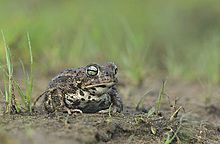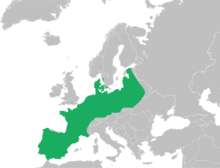Natterjack toad
| Natterjack toad | |
|---|---|

| |
| Scientific classification | |
| Domain: | Eukaryota |
| Kingdom: | Animalia |
| Phylum: | Chordata |
| Class: | Amphibia |
| Order: | Anura |
| Family: | Bufonidae |
| Genus: | Epidalea Cope, 1864 |
| Species: | E. calamita
|
| Binomial name | |
| Epidalea calamita (Laurenti, 1768)
| |

| |
| Synonyms | |
| |
The natterjack toad (Epidalea calamita) is a toad native to sandy and heathland areas of Europe and the United Kingdom. Adults are 60–70 mm (2.4–2.8 in) in length, and are distinguished from common toads by a yellow line down the middle of the back and parallel paratoid glands. They have relatively short legs, which gives them a distinctive gait, contrasting with the hopping movement of many other toad species.
Natterjacks have a very loud and distinctive mating call amplified by the single vocal sac found under the chin of the male.
Life history
[edit]



Natterjacks live for up to 15 years, and feed mainly on insects, especially beetles. At night, they move around open terrain with sparse vegetation, and their tracks can often be seen in loose sand. They move considerable distances each night, enabling the species to colonize new habitats very quickly.
Reproduction
[edit]The natterjack toad spawns between the end of April and July, laying strings of eggs in shallow, warm pools. Because the natterjack toad is often present in low numbers, its loud mating calls are important so that the sexes can find each other.
Natterjacks can only spawn in pools that have a very slightly sloping bottom, and tolerate only sparse vegetation on the banks and in the water. Since pools of this description are often temporary, sometimes the tadpoles die when the pools dry out. The natterjack compensates for that risk by mating over an extended period each summer. Thus, in September, the age of the juveniles can vary from one to three months. Early breeders seldom breed again later in the season, though some females do spawn twice in a year.
Distribution
[edit]Populations of the natterjack extend through 17 European countries.[2] In the UK, the toad is now almost completely confined to coastal sites. The natterjack is the only species of toad native to Ireland. It is found in County Kerry (Dingle Peninsula and Derrynane) and also in County Wexford, where it was introduced to a dune site.[2][3]
In mainland Europe, particularly in the southern part of its range, it lives inland in a variety of habitats.
Conservation
[edit]UK
[edit]In the UK, the threatened status of the species resulted in a national Biodiversity Action Plan designating it as one of three protected amphibians. Reasons for its threatened status[citation needed] include:
- Loss of habitat from human overpopulation
- Deterioration and loss of lowland heaths
- Reduction in habitable coast from construction of dykes and seawalls
- Acidification of aquatic habitat from acid rain and other pollution
In England, the toad's sand dune habitat is protected by a number of national nature reserves. For example, in the north-west, reserves are at Hoylake, Ainsdale Sand Dunes,[4] North Walney and Sandscale Haws. In Scotland, where the species is confined to the Solway Firth, a reserve is at Caerlaverock. In Wales, the species became extinct in the 20th century, but has been reintroduced as part of the Biodiversity Action Plan.[5]
Ireland
[edit]To reverse habitat loss, the National Parks and Wildlife Service has created ponds for the species with some funding from the Heritage Council.[2] The natterjack is considered endangered in Ireland. As of July 2021[update], a project involving Fota Wildlife Park and the National Parks and Wildlife Service has released 6,000 toadlets into their natural range in County Kerry.[6]
The natterjack toad is used as a symbol for Dooks Golf club in Kerry.[7][failed verification]
References
[edit]- ^ IUCN SSC Amphibian Specialist Group (2022). "Epidalea calamita". IUCN Red List of Threatened Species. 2022: e.T54598A89700822. doi:10.2305/IUCN.UK.2022-1.RLTS.T54598A89700822.en. Retrieved 13 April 2024.
- ^ a b c Viney, M. (4 April 2011). "Here's what biodiversity has done for us". The Irish Times. Archived from the original on 23 October 2012.
- ^ Korky, J.K. (2008). "Notes on the 2007 breeding season of the Natterjack Toad Epidalea calamita Laurenti (Anura: Bufonidae) in Ireland". Bull. Ir. Biogeog. Soc. 32: 21–31.
- ^ "North Merseyside Biodiversity Action Plan – Natterjack Toad" (PDF). Archived from the original (PDF) on 3 August 2014.
- ^ "Natterjack toads return to North Wales". 11 June 2001. Archived from the original on 3 August 2014.
Toads from Merseyside have repopulated former strongholds in sand dunes around Talacre, with the help of the Herpetological Conservation Trust.
- ^ "Croak park as 500 natterjack toadlets go wild in Kerry". Dublin: RTÉ News and Current Affairs. 30 July 2021. Retrieved 31 July 2021.
- ^ "Dooks Golf Club - Kerry Links Golf | Golfing in Kerry | Kerry Golf Courses". Dooks Golf Club. Retrieved 29 September 2023.
Further reading
[edit]- Beebee T and Denton J (1992) An evaluation of survey methods for studying natterjack toads (Bufo calamita) outside the breeding season. Amphibia-Reptilia 13: 365–374.
- Beebee T and Denton J (1996) Natterjack Toad Conservation Handbook. English Nature, Peterborough.
- Herpetological Conservation Trust (2009) Natterjack Toad Species Action Plan. Bournemouth.
- The Herpetological Conservation Trust (undated) Natterjack Toad Survey Guidelines. Bournemouth.
- Natural England (2011) Standing Advice Species Sheet: Natterjack toads. Sheffield.
External links
[edit]- Amphibians and Reptiles of Europe
- Fauna Europaea West Palaearctic distribution.
- Natterjack Toad Species Action Plan (pdf). Amphibian & Reptile Conservation (July 2009) — via Internet Archive.
- Natterjack Toad V 2.1. (Species Action Plan) (pdf) Cumbria Biodiversity Data Centre (April 2010).
- Competencies for Species Survey: Natterjack Toad (pdf). Chartered Institute of Ecology and Environmental Management – CIEEM (25 April 2013).
- Jonathan Warren (1999). "Dumfries & Galloway Local Species Action Plan: Natterjack Toad". Dumfries & Galloway Local Biodiversity Action Plan. Dumfries and Galloway Council. Archived from the original on 4 March 2016. Retrieved 2 November 2015.
- "Natterjack toad (Bufo calamita)". Wildscreen Arkive. n.d. Archived from the original on 8 March 2015. Retrieved 2 November 2015.
- Scottish Natural Heritage and Forestry Commission (n.d.). "All About ... Natterjack toad" (PDF). Retrieved 2 November 2015.
- "Natterjack Toad". Froglife. 2015. Retrieved 2 November 2015.
- Natural England and Department for Environment, Food & Rural Affairs (9 October 2014). "Natterjack toads: surveys and mitigation for development projects". Gov.UK. Retrieved 2 November 2015. Last updated 2015-05-12.

